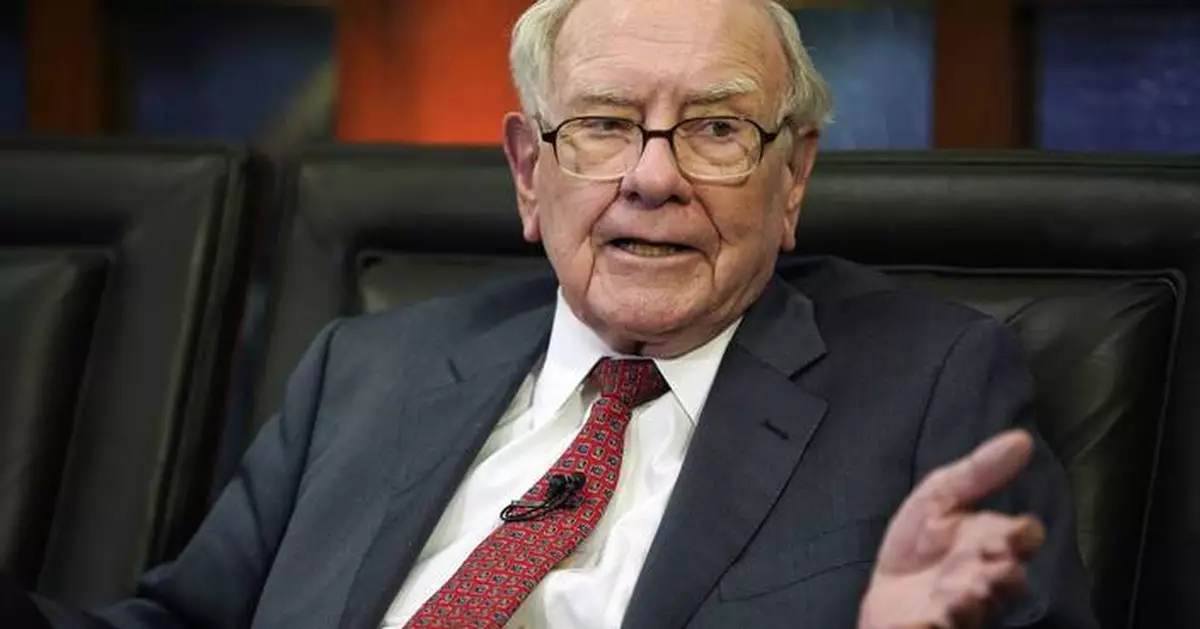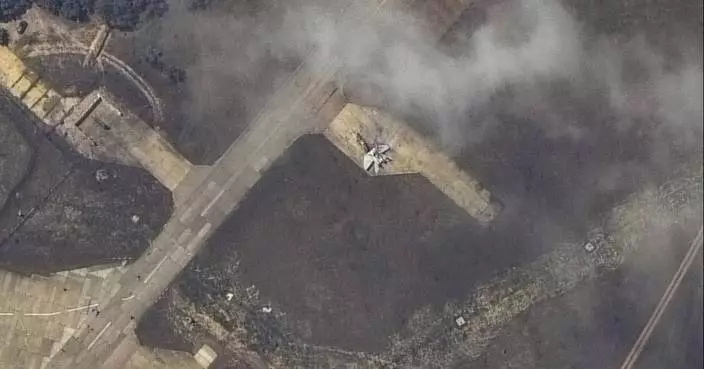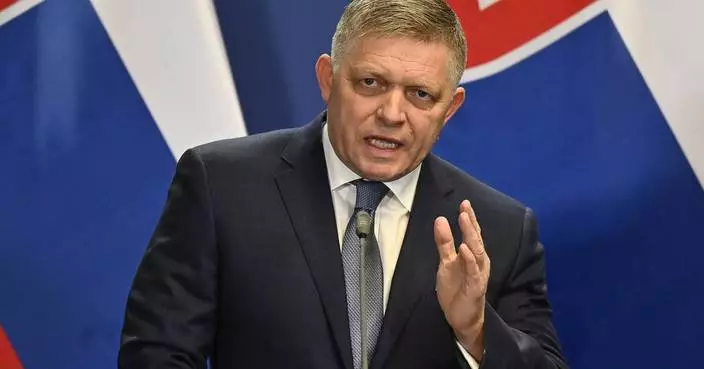OMAHA, Neb. (AP) — Everyone knows Warren Buffett 's successor won't be able to match the legendary investor, but Berkshire Hathaway 's board remains confident Greg Abel is the right guy to one day lead the conglomerate into the future.
Longtime Berkshire board member Ron Olson told investors gathered Thursday at a conference two days ahead of the company's annual shareholders meeting that Abel understands all the fundamental principles that guided Buffett, like letting Berkshire's companies largely run themselves. And Abel will be committed to running Berkshire in a conservative way that will protect the company that's known for it financial strength, he said.
“Greg is not somebody who is going to be as likely to create the kind of following in the press that I think Warren has had,” Olson said. “On the other hand. I have every reason to believe that he will run the companies that we have the responsibility for in the same way that Warren ran them.”
Olson said he's confident business owners will still be willing to sell their companies to Berkshire once the Canadian utility executive takes over after the 93-year-old Buffett is gone.
Olson said he doesn't think last year's public legal fight with the billionaire Haslam family over how much Berkshire would ultimately pay for the last 20% of the Pilot truck stop chain the family agreed to sell to Buffett will be a deterrent to future deals either. Both the Haslams and Berkshire accused each other of trying to manipulate Pilot's earnings to affect the final $2.6 billion price.
Business owners considering selling can see all the positive and respectful relationships Berkshire has with its dozens of other subsidiaries on display in the 200,000-square-foot exhibit hall adjoining the arena where Saturday's meeting will be held, Olson said.
In fact the legal battle gave Olson, who is a partner at Berkshire's primary law firm, the chance to work closely with Abel, giving him even more confidence in the board's chosen successor.
“I could tell you that his preparation and thinking was impressive. He is strategic in his thinking. And he is decisive in his judgement,” Olson said.
Plus, Berkshire is sitting on more than $167 billion cash, so it has ample resources to do deals and, Olson said, “people generally like to be paid in cash.”
Abel, who keeps a low profile and doesn't typically grant interviews, will be answering questions alongside Buffett for hours Saturday, trying to help fill the role Buffett's longtime partner Charlie Munger held for decades before he died last fall. Abel has been overseeing all of Berkshire's varied non-insurance businesses for several years while another vice chairman, Ajit Jain, oversees the insurance businesses, including Geico and General Reinsurance.
Olson said Abel is a numbers guy who can dissect a business' balance sheet as quickly and well as Buffett, and he's also a great listener that people like to work with.
But, Olson said, “Greg is not going to be as entertaining as Warren and Charlie have been through the years.”
So Munger's absence will be felt acutely on Saturday by all the thousands of people attending the meeting. There simply is no way to replace the expertise, advice and friendship Munger offered to Buffett for more than six decades.
Professor Lawrence Cunningham, who has written several books about Berkshire, said he thinks even with the profound loss of Munger the company he helped build will endure.
“The chair is empty. There’s no way to fill it. But I’m also confident that Warren — and especially Greg and Ajit — will carry on the torch,” Cunningham said.
Berkshire has been grappling with succession questions for decades, but Cunningham said he thinks Buffett and Munger built an organization bigger than themselves that will endure.
Olson said Berkshire's board knows there just isn't another Warren Buffett or Charlie Munger out there to replace those two men.
After Buffett dies, Berkshire will face pressure as the shareholder base evolves to include more index and activist investors. One of the things investors may demand is that Berkshire change its longstanding policy and start paying a dividend if it can't find a good use for all that cash.
Olson said the board hasn't ruled out paying a dividend at some point in the future, but it also hasn't seriously considering approving one now with Buffett still at the helm.

FILE - Berkshire Hathaway Vice Chairman Greg Abel is seen at the CenturyLink Center, May 5, 2018, in Omaha, Neb. Everyone knows Warren Buffett's successor won't be able to match the legendary investor, but Berkshire Hathaway's board remains confident that Abel is the right guy to one day lead the conglomerate into the future. (AP Photo/Nati Harnik, File)

FILE - Berkshire Hathaway Chairman and CEO Warren Buffett speaks during an interview with Liz Claman on Fox Business Network's "Countdown to the Closing Bell," May 7, 2018, in Omaha, Neb. Everyone knows Buffett's successor won't be able to match the legendary investor, but Berkshire Hathaway's board remains confident that Greg Abel is the right guy to one day lead the conglomerate into the future. (AP Photo/Nati Harnik, File)
WASHINGTON (AP) — Trucks carrying badly needed aid for the Gaza Strip rolled across a newly built U.S. pier and into the besieged enclave for the first time Friday as Israeli restrictions on border crossings and heavy fighting hindered the delivery of food and other supplies.
The shipment is the first in an operation that American military officials anticipate could scale up to 150 truckloads a day, all while Israel presses in on the southern city of Rafah in its 7-month offensive against Hamas.
But the U.S. and aid groups warn that the floating pier project is not a substitute for land deliveries that could bring in all the food, water and fuel needed in Gaza. Before the war, more than 500 truckloads entered the territory on an average day.
The operation's success also remains tenuous because of the risk of militant attack, logistical hurdles and a growing shortage of fuel for the trucks to run due to the Israeli blockade of Gaza since Hamas' Oct. 7 attack. Militants killed 1,200 people and took 250 others hostage in that assault on southern Israel. The Israeli offensive since has killed more than 35,000 Palestinians in Gaza, local health officials say, while hundreds more have been killed in the West Bank.
Aid agencies say they are running out of food in southern Gaza and fuel is dwindling, while the U.S. Agency for International Development and the World Food Program say famine has already taken hold in Gaza’s north.
Troops finished installing the floating pier on Thursday, and the U.S. military's Central Command said the first aid crossed into Gaza at 9 a.m. Friday. It said no American troops went ashore in the operation.
“This is an ongoing, multinational effort to deliver additional aid to Palestinian civilians in Gaza via a maritime corridor that is entirely humanitarian in nature, and will involve aid commodities donated by a number of countries and humanitarian organizations,” the command said.
The Pentagon said no backups were expected in the distribution process, which is being coordinated by the United Nations.
The U.N., however, said fuel deliveries brought through land routes have all but stopped and this will make it extremely difficult to bring the aid to Gaza’s people.
“We desperately need fuel,” U.N. deputy spokesperson Farhan Haq said. “It doesn’t matter how the aid comes, whether it’s by sea or whether by land, without fuel, aid won’t get to the people.”
Pentagon spokesperson Sabrina Singh said the issue of fuel deliveries comes up in all U.S. conversations with the Israelis. She also said the plan is to begin slowly with the sea route and ramp up the truck deliveries over time as they work the kinks out of the system.
Israel fears Hamas will use fuel in the war, but it asserts it places no limits on the entry of humanitarian aid and blames the U.N. for delays in distributing goods entering Gaza. Under pressure from the U.S., Israel has opened a pair of crossings to deliver aid into the territory’s hard-hit north in recent weeks.
It has said that a series of Hamas attacks on the main crossing, Kerem Shalom, have disrupted the flow of goods. The U.N. says fighting, Israeli fire and chaotic security conditions have hindered delivery. There have also been violent protests by Israelis that disrupted aid shipments.
Israel recently seized the key Rafah border crossing in its push against Hamas around that city on the Egyptian border, raising fears about civilians' safety while also cutting off the main entry for aid into the Gaza Strip.
U.S. President Joe Biden ordered the pier project, expected to cost $320 million. The boatloads of aid will be deposited at a port facility built by the Israelis just southwest of Gaza City and then distributed by aid groups.
U.S. officials said the initial shipment totaled as much as 500 tons of aid. The U.S. has closely coordinated with Israel on how to protect the ships and personnel working on the beach.
But there are still questions about the safety of aid workers who distribute the food, said Sonali Korde, assistant to the administrator of USAID's Bureau for Humanitarian Assistance, which is helping with logistics.
“There is a very insecure operating environment,” and aid groups are still struggling to get clearance for their planned movements in Gaza, Korde said.
That concern was highlighted last month when Israeli strike killed seven relief workers from World Central Kitchen whose trip had been coordinated with Israeli officials. The group had also brought aid in by sea.
Pentagon officials have made it clear that security conditions will be monitored closely and could prompt a shutdown of the maritime route, even if just temporarily. Navy Vice Adm. Brad Cooper, a deputy commander at the U.S. military’s Central Command, told reporters Thursday that “we are confident in the ability of this security arrangement to protect those involved.”
Already, the site has been targeted by mortar fire during its construction, and Hamas has threatened to target any foreign forces who “occupy” the Gaza Strip.
Biden has made it clear that there will be no U.S. forces on the ground in Gaza, so third-country contractors will drive the trucks onto the shore.
Israeli forces are in charge of security on shore, but there are also two U.S. Navy warships nearby that can protect U.S. troops and others.
The aid for the sea route is collected and inspected in Cyprus, then loaded onto ships and taken about 200 miles (320 kilometers) to the large floating pier off the Gaza coast. There, the pallets are transferred onto the trucks that then drive onto the Army boats, which will shuttle the trucks from the pier to a floating causeway anchored to the beach. Once the trucks drop off the aid, they return to the boats.
Gambrell reported from Dubai, United Arab Emirates.

The image provided by U.S, Central Command, shows U.S. Army soldiers assigned to the 7th Transportation Brigade (Expeditionary), U.S. Navy sailors assigned to Amphibious Construction Battalion 1, and Israel Defense Forces placing the Trident Pier on the coast of Gaza Strip on Thursday, May 16, 2024. The temporary pier is part of the Joint Logistics Over-the-Shore capability. The U.S. military finished installing the floating pier on Thursday, with officials poised to begin ferrying badly needed humanitarian aid into the enclave besieged over seven months of intense fighting in the Israel-Hamas war. (U.S. Central Command via AP)

The image provided by U.S, Central Command, shows U.S. Army soldiers assigned to the 7th Transportation Brigade (Expeditionary), U.S. Navy sailors assigned to Amphibious Construction Battalion 1, and Israel Defense Forces placing the Trident Pier on the coast of Gaza Strip on Thursday, May 16, 2024. The temporary pier is part of the Joint Logistics Over-the-Shore capability. The U.S. military finished installing the floating pier on Thursday, with officials poised to begin ferrying badly needed humanitarian aid into the enclave besieged over seven months of intense fighting in the Israel-Hamas war. (U.S. Central Command via AP)

This satellite image from Planet Labs PBC shows a pier installed by the U.S. military in the Gaza Strip on Thursday, May 16, 2024. (Planet Labs PBC via AP)

The image provided by U.S, Central Command, shows U.S. Army soldiers assigned to the 7th Transportation Brigade (Expeditionary), U.S. Navy sailors assigned to Amphibious Construction Battalion 1, and Israel Defense Forces placing the Trident Pier on the coast of Gaza Strip on Thursday, May 16, 2024. The temporary pier is part of the Joint Logistics Over-the-Shore capability. The U.S. military finished installing the floating pier on Thursday, with officials poised to begin ferrying badly needed humanitarian aid into the enclave besieged over seven months of intense fighting in the Israel-Hamas war. (U.S. Central Command via AP)















